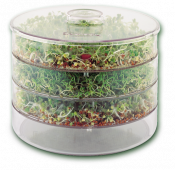How to Sprout Seeds
Germination is a natural process that depends on the right supply of moisture, light and air. The motto is: neither too much nor too little.
First time cultivators should choose types of seedling that germinate easily, such as mung beans, cress, alfalfa or radishes.
1 Prepare
Rinse the glass germinator with cold water. Put the germinator in a bright, warm place. Avoid direct sunlight.
2 Rinse
Place seeds in glass. After fitting the sieve over the glass opening, fill with fresh, cold water and allow water to drain out again immediately.
3 Soak
Pour enough cold water into the glass to cover the seeds. Move the seeds around in the glass germinator from time to time to aerate them.
4 Water
After fitting the sieve over the glass opening, fill with fresh, cold water and allow water to drain out again immediately. Then place the
germinator on a dish with the sieve pointing downwards at an angle to allow any remaining water to drain off
5 Harvest
Harvest fresh, crunchy shoots and sprouts 3-7 days later.
All the objects used must be carefully cleaned (glass germinator, sieve, water container, spoon etc.), preferably using fruit vinegar and a soft brush. The germinator can be dishwashed. Rinse with clear water and leave to dry.
At the beginning, note seed-related information such as sowing quantity and soaking and watering times in the seed table. You can then adapt these values depending on your own experiences.
The glass germinator is not suitable for mucilaginous seeds such as cress! Wash harvested sprouts before consuming. If not eaten immediately, they should be stored in the fridge (for no longer than 2-3 days.
1 Prepare
Rinse the germinator with cold water. Put the germinator in a bright, warm place where it stands level on all sides. Avoid direct sunlight.
The little red drainage siphons must sit correctly, but not too tightly on the water drainage tubes.
2 Rinse
Rinse the seeds well in a sieve under running water before sowing.
3 Sow
Scatter a thin layer of seeds on the seed tray. Once sown with seeds, stack the trays one on top of each other so that the red drainage
siphons are staggered and not directly above one another.
4 Water
Pour water into the top tray until the siphon cone is completely covered (min. 0.5 l) and the water starts to drain off. The individual
sowing trays containing the seeds are now automatically watered in sequence. A small amount of water is left behind in each tray in
order to provide ambient moisture, which is ideal for the seeds. Once the water has flowed through the germinator, empty the
surplus water tray and fill with a little fresh water – enough to cover the bottom.
5 Harvest
Harvest fresh, crunchy shoots and sprouts 3-7 days later.
All the objects used must be carefully cleaned (germinator, siphon cones, water container, spoon etc.), preferably using fruit vinegar and a soft brush. The germinator can be dishwashed (in the top tray, max. 85°C). Rinse with clear water and leave to dry.
At the beginning, note seed-related information such as sowing quantity and watering time in the seed table. You can then adapt these values depending on your own experiences.
For mucilaginous seeds such as cress: once the mucilage has started to form, only spray with fresh water.
Wash harvested sprouts before consuming. If not eaten immediately, they should be stored in the fridge (for no longer than 2-3 days).
A.Vogel Blog – Natural and Healthy
Inspiration for a healthy life!
HERBAMARE SOUP-ER SOUPS!
DOWNLOAD YOUR FREE RECIPE BOOKLET!
8 healthy, hearty and delicious homemade soups.
Supporting a healthier happier you
“Nature is just about the best thing we’ve got!“
Alfred Vogel's guide to leading a healthy and happy life
Healthy & nutritious dinner ideas
Get new recipes in your inbox every month. Sign up now
